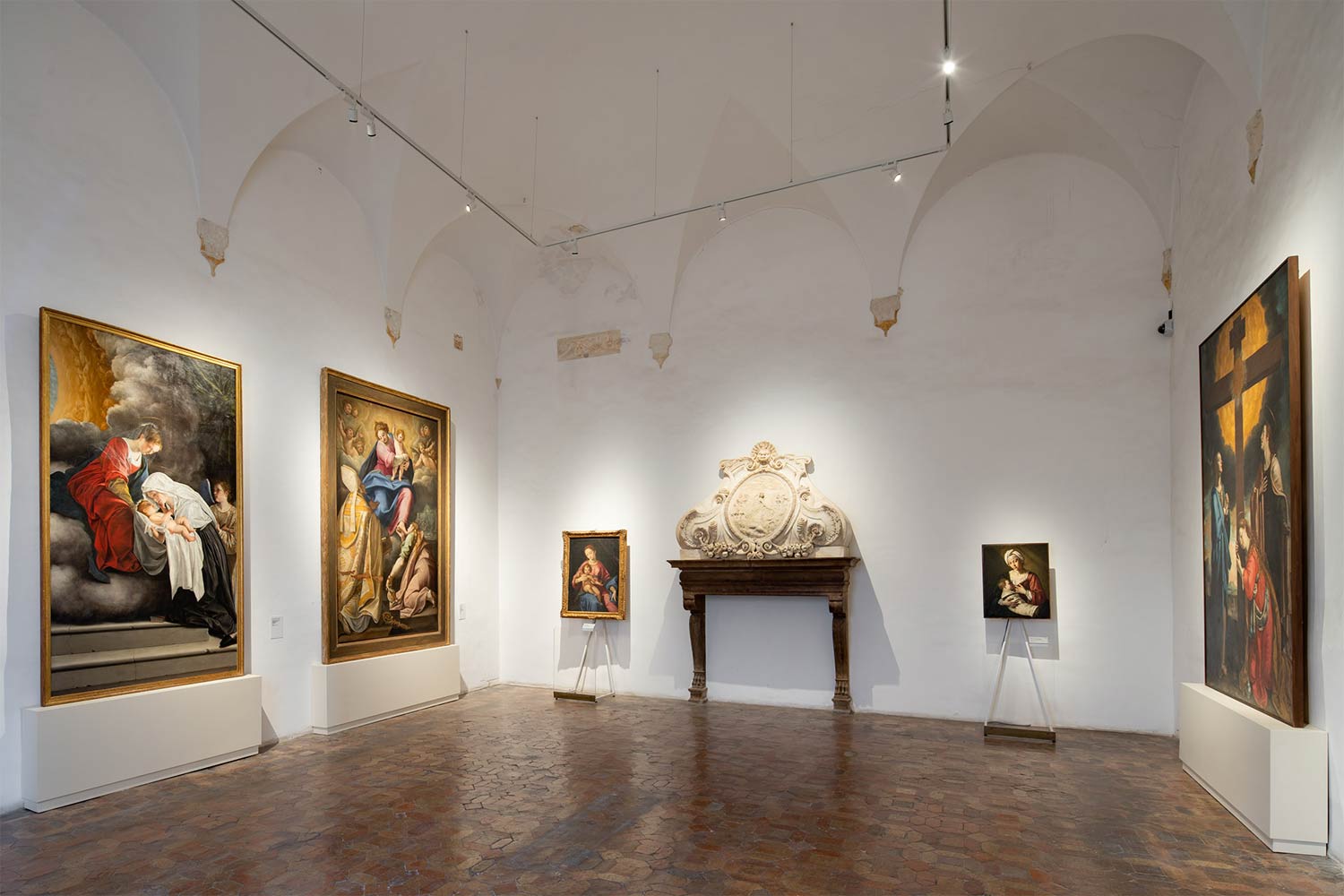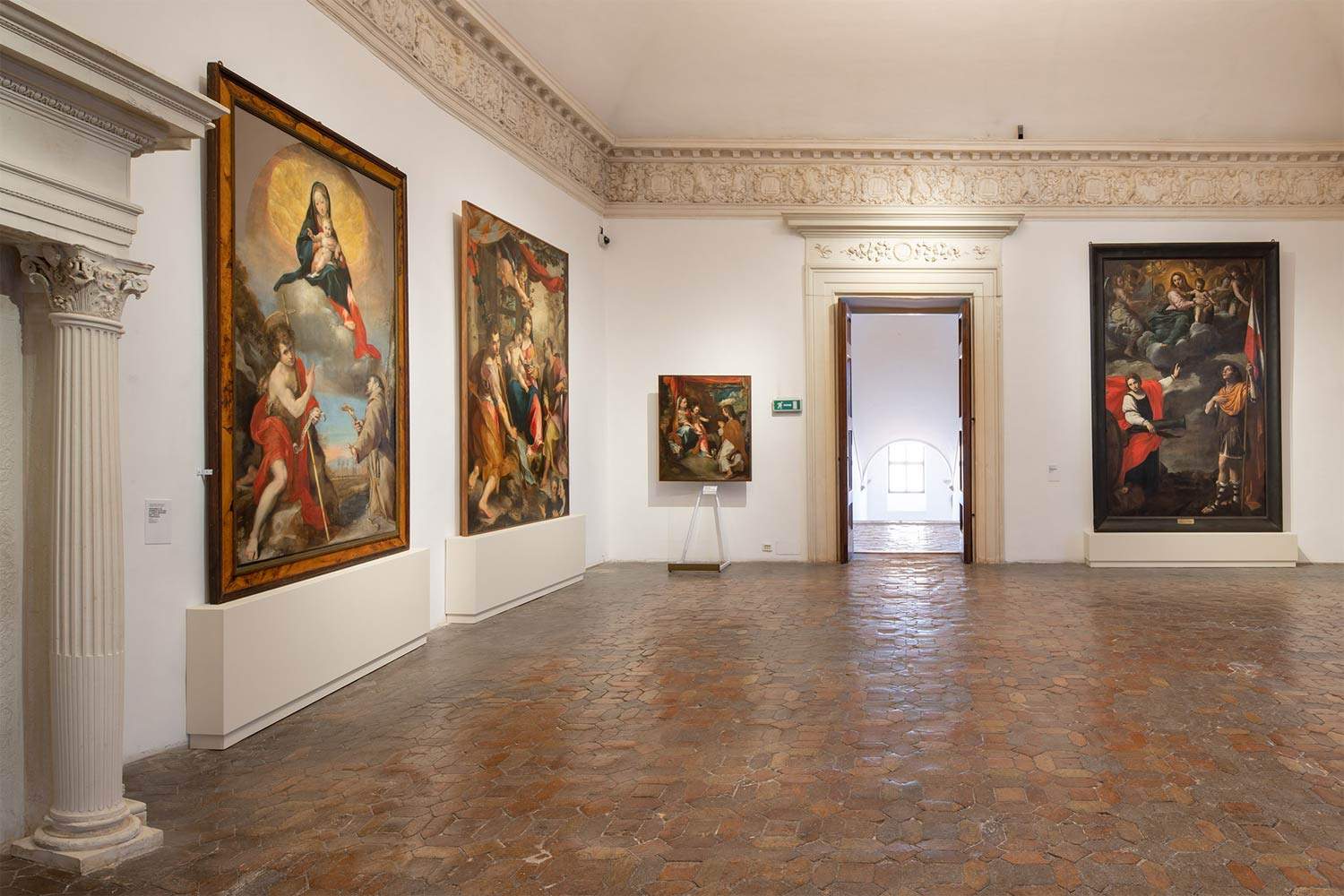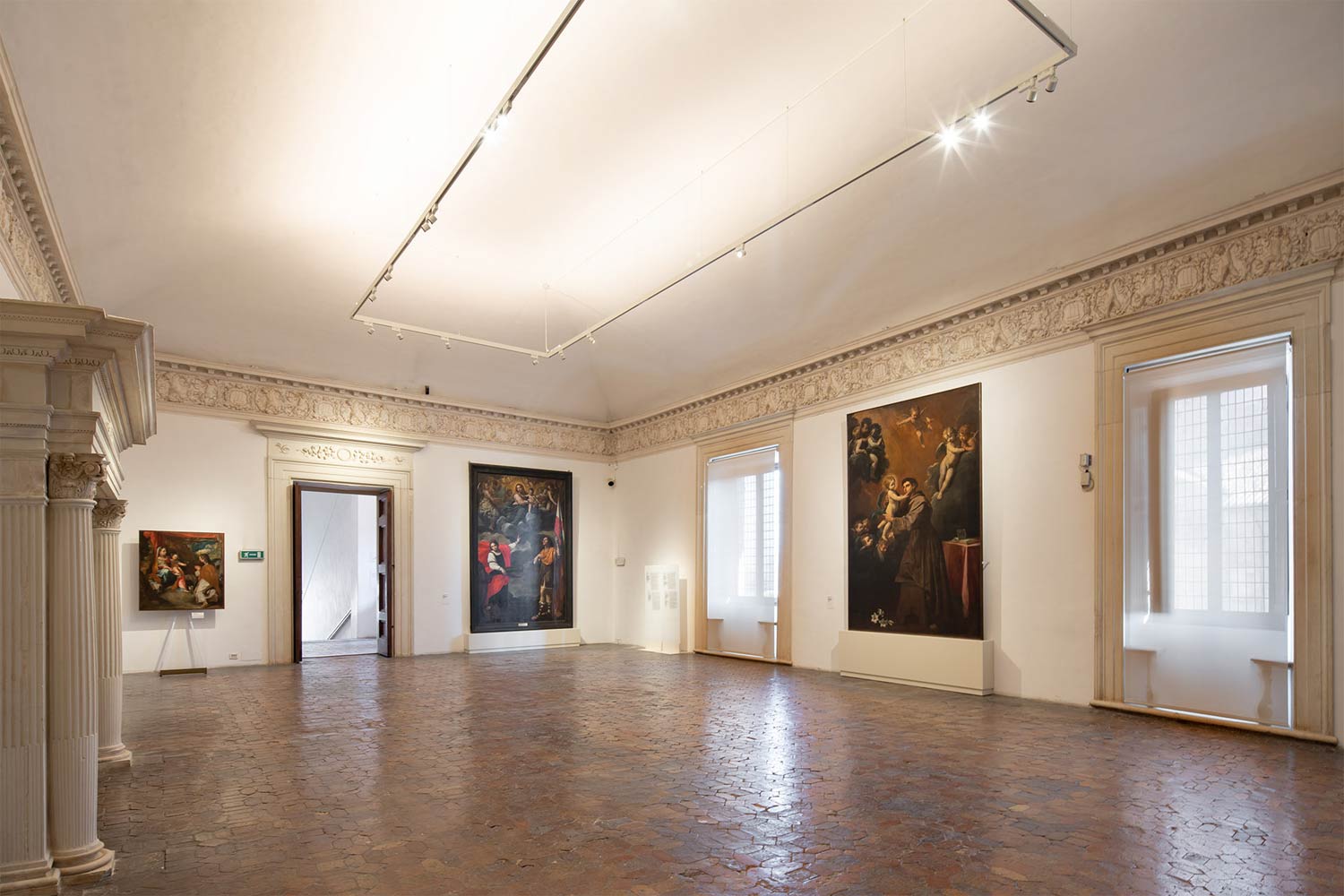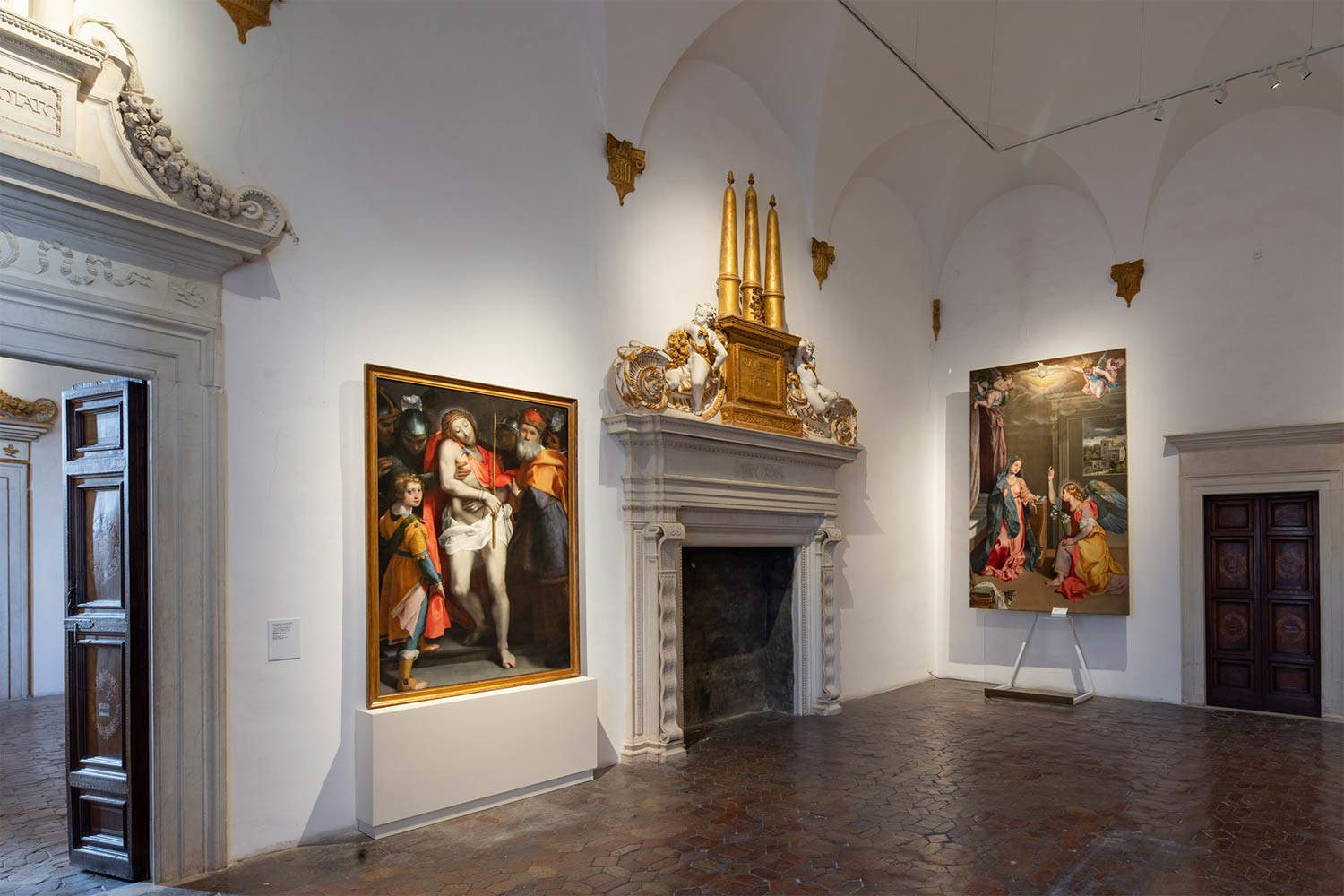In Urbino, the Galleria Nazionale delle Marche is expanding and on July 14 will inaugurate the western wing of the second floor, with eight rooms devoted to paintings from the 16th to the 18th century, landscape, portraiture, the Albani pontificate and the Volponi Collection. This opening will conclude the musealization of the upper floor of the historic Urbino building, allowing the Marche museum to house nearly 100 more works than before. The musealization of these spaces was made necessary by the increase in the collections of the Galleria Nazionale delle Marche and, in particular, by the deposit of the rich collection of the Cassa di Risparmio di Pesaro. The latter consists of about 200 paintings, ranging from the 15th century to the contemporary age, all from the Marche region, and about 200 ceramics whose production-from the 15th century onward-represents excellence in the area. The bulk of the collection of the Cassa di Risparmi di Pesaro, sees works from the seventeenth and eighteenth centuries, from the area of the Marche so it constitutes an indispensable addition to the narrative of Marche art well represented for the fifteenth and sixteenth centuries by the permanent collection of the Galleria Nazionale delle Marche.
“With the opening of the new rooms on the second floor, spaces that had never before been musealized,” says director Luigi Gallo, “the process of reconverting the entire building for cultural purposes, which began with the establishment of the Galleria Nazionale delle Marche in 1912 under the direction of a very young Lionello Venturi, is brought to completion. In addition to increasing the exhibition spaces and, consequently, the quantity of works on display, the operation includes in the itinerary spaces of great value that were previously not visible to the public, such as the southern turret, the loggia and the Gallo terrace.”



The rooms in this part of the palace are the result of an architectural addition already begun by the Montefeltro family in the eastern and southern wings of the building and later brought to completion by the Della Rovere family. At the behest of Guidubaldo II (1514-1574) in the mid-16th century the entire floor was completed and decorated, with the elevation of the 15th-century crenellated terraces by Bartolomeo Genga and Filippo Terzi. In the 1960s in particular, the so-called “roveresco apartment” was then restored and modernized, corresponding to the Sale della Jole below. Not always as well preserved as originally, the decoration of these rooms, by sculptor Federico Brandani (1525-1575), is very similar to that of the Appartamento degli Ospiti on the piano nobile. The doors of the rooms are surmounted by large stucco decorations characterized by imposing Roveresque emblems. In the second room above the large fireplace, placed in front of the entrance to catch the visitor’s eye, is the heraldic symbol of the Three Goals, which is widespread in the plastic decoration throughout the floor. Underneath the emblem, placed above a scroll pedestal on which two shapely putti are resting, one can read the motto Filaretotato (lover of virtues), which alludes to the moral qualities of the patron Guidubaldo II. In the Gallery overlooking the Cortile del Pasquino, whose walls still show signs of the original battlements, a grotesque decoration, also referable to the time of Guidubaldo II, was discovered in recent times.
Two peculiarities are worth noting: one of the Gallery’s back walls is painted with one of the oldest views of the city of Urbino, while in the masonry of one of the adjacent rooms can be seen the large cylindrical flues, once soaring over the roof, incorporated into the wall face during the renovation phases promoted by Guidubaldo II. Theeastern wing of the second floor, corresponding to the roveresco apartment, had already been musealized and housed works from the late 16th century-with the important nucleus of works by Federico Barocci-and the 17th century. The gallery toward the Pasquino Garden and some adjoining rooms were intended for the display of ceramics and some of the graphics. Other spaces, also on the eastern side, housed the offices of the Marche National Gallery Management and the Marche Regional Museums Management. The western arm, on the other hand, had been partially recovered to adapt it for offices of the superintendency, work that was not completed given the latter’s relocation to Ancona. This part of the palace had not yet been used because it remained occupied, until the late 1980s, by the Scuola del Libro, which shared, with the Galleria Nazionale delle Marche, the use of the Ducal Palace. Other teaching spaces were obtained on the ground floor and in the rooms above the Duchess’s Apartment. These spaces present, in part, a more recent decorative apparatus, dating back to the 18th and 19th centuries when, in these rooms, public offices related to the functions of the papal delegation that had taken up residence in the palace were located.
The recovery of these spaces involved a rethinking of the museographic arrangement of the entire Galleria Nazionale delle Marche. By increasing the spaces available, first of all it was possible to give more breathing space to the works exhibited on the second floor: here the entire display of works from the fourteenth to the mid-sixteenth century remains, culminating with the masterpieces of the Frederician age that are inserted near the characteristic spaces of the period: the Studiolo, the Salone del Trono, and the Sala degli Angeli. The second floor, on the other hand, will host works from the mid-sixteenth century to the eighteenth century. Here the itinerary starts from the rooms dedicated to Barocci and his followers. The nucleus of his works has been further enriched in recent times thanks to the MiC initiative 100 works return home: in fact, as part of the project of temporary exhibition at other museums of works from the deposits of major museums, two more works by Federico Barocci from the Pinacoteca di Brera have entered (and will remain for ten years) in the collections of the Galleria Nazionale delle Marche. The same initiative has enriched this section of the museum with three more works, two by Simone Cantarini and one by Cristoforo Roncalli known as il Pomarancio.
The rooms on the second floor will also house works by other artists active in the Marche region, such as Orazio Gentileschi, or of Marche origin, such as Francesco Guerrieri and Giovan Battista Salvi known as Sassoferrato. This is followed by a number of works by Zuccari, painters from Sant’Angelo in Vado, a locality close to Urbino-part owned by the Galleria Nazionale delle Marche and part coming from the depository of the Cassa di Risparmio di Pesaro-and Federico Barocci, the great Urbino painter whose paintings and drawings the Galleria Nazionale delle Marche holds a rich nucleus of; also included among the 16th-century works are paintings by Tintoretto, Boscoli, Maso da San Friano, Naldini and others.
Also relocated to the new rooms on the second floor will be the Volponi Donation, the collection of writer Paolo Volponi donated-in two tranches-to the Galleria Nazionale delle Marche, in memory first of Roberto, the senator’s son who died tragically in a plane crash, and then of Paolo himself, by his heirs. Except for a very small nucleus of works from the fourteenth to fifteenth centuries with a gold background, the collection consists mainly of works from the Roman seventeenth century with masterpieces by Guido Reni, Giovanni Lanfranco, Guercino, Mattia Preti, as well as the various Ribera, Gentileschi, Battistello Caracciolo, and Salvatore Rosa. The section on the eighteenth century will focus on the pontificate of Clement XI, born Giovanni Francesco Albani, who was a native of Urbino and who, for that reason, represented a particularly flourishing moment for the city in the Marche region from a cultural and artistic point of view. The layout of the second floor also includes two thematic sections: one dedicated to landscapes and one to portraits. Because of the peculiarities specific to the Montefeltro landscape, the former takes on a particularly significant connotation.
Other specific sections that have already found a place in the new rooms are the Cabinet of Drawings, which offers the opportunity to exhibit not only two monumental cartoons by Domenichino and Carracci, but also a selection from the graphic collection of the Galleria Nazionale delle Marche, which will see alternating - among others - numerous drawings by Barocci himself, of which the Institute has a rich selection. Then there is the Pasquino Gallery and the adjoining room, which allow visitors to admire a rich review of ceramics of which Montefeltro was a land of excellent production. This review is formed partly by the collections of the Gallery itself (which also include a nucleus of materials from excavations carried out in the Ducal Palace itself) and some deposits from private collections as well as a rich nucleus of pieces from the Fondazione della Cassa di Risparmio di Pesaro.


 New
NewThe layout of the rooms on the second floor is characterized by different declinations depending on the architectural characterization of the rooms and the materials to be displayed. A minimalist intervention characterizes the roveresque rooms of the eastern arm, which, distinguished by refined fireplaces, portals and framed windows, see the protagonist the lighting system that enhances these elements and the works on display, simply hung on the walls, ensuring the best visibility of each other. The care of the lighting system, homogeneous throughout the entire floor, also characterizes the rooms on the western arm: the eight new rooms on this side, lacking the architectural elements of the previous ones, are also “disturbed” by a previous plant system that needed to be hidden. Therefore, panelling was done to conceal some elements of these systems and support the works, distributed on the three sides of each room taking care to always leave the windowed wall facing outward and the beautiful landscape from the windows free. Ad hoc interventions were required by the Cabinet of Drawings, with a calibrated lighting system to ensure the preservation of the delicate graphic works. Elegant display tables have also been set up here to allow easy replacement of the drawings, which will thus be displayed in rotation from month to month, both for conservation needs and to allow subsequent viewing of the various pieces in the possession of the Galleria Nazionale delle Marche, which includes a rich fund of drawings by Federico Barocci.
The section devoted to ceramics has its strong point in the Pasquino Gallery overlooking the garden of the same name: from the windows - facing south - the sun invades the space, enhancing the chromatic richness of the ceramics on display. In the last bays of the loggia, among other things, the grotesque decorations dating back to the mid-sixteenth century and commissioned by Guidobaldo II della Rovere have resurfaced: they will soon undergo a major restoration, but the lighting has already been designed to enhance them. Incidentally, remember, that one of the lunettes depicts precisely the city of Urbino with the Ducal Palace.
The interventions allowed the recovery of some architectural elements that had not been well evaluated previously: the corridor leading to the entrance of the Torricino, for example, had capitals that were barely legible under the many layers of paint. Their cleaning made it possible to recognize them as the work of Federico Brandani, the famous Urbino plastier who created the decorations of the Appartamento Roveresco, the Camerino Dorato and the Chapel of Gudobaldo II.
The itinerary of the second floor ends with the room dedicated to the Albani pontificate: here, an overlook allows one to see the extrados of the vault of the underlying Throne Room, built in masonry with wooden chains. The grandiose environment in fact, develops considerably in height occupying, almost entirely, two entire floors of the building reaching the same level as the rooms on the second floor.

 New
New New
NewThe rehabilitation of the second floor did not concern only the rooms located on this level, but starts from a series of interventions aimed at the functional optimization of the entire structure and, in particular, at the net improvement of accessibility and the adaptation of security systems.
In this context, the construction of the new elevator connecting the second floor to the second must be evaluated. In fact, there was already one that made the second floor accessible to those with mobility difficulties, but its location did not allow its ride to be extended to the second floor. Thus, at a point relatively close to the previous one, another one was built - smaller in size and, technically, with an elevating platform - making it possible to reach from this first level, the other one above. The location has made the impact on the ancient and valuable structure of the fifteenth-century Ducal Palace very low: minimal demolition and tampering with the original structure, sufficient service for users who need the use of a climbing device other than the staircase, a defiladed and discreet position with very low aesthetic impact.
In addition to responding to the general idea of ever-improving accessibility to places of culture, characteristic of the cultural policy of these years, this device also made it possible to solve a particular junction of the palace where it was possible to restore access to one of the overlooks of the Melaranci loggia (previously precluded to the public) and to obtain a toilet on the second floor, which, prior to the work, was lacking. Thus, in addition to improved accessibility, a better level of user services and the recovery of an evocative historical space has been achieved, which has an extremely favorable impact on the enhancement of the architectural complex of the Ducal Palace.
A similar system of improvements, albeit with reversed priorities, occurs with the rehabilitation of the south tower. Unlike what was seen for the creation of the elevator, here it is the recovery of an architectural element of very strong iconic value, which has also allowed an improvement at the level of safety and an enrichment of the paths. Altered and degraded by improper use and inadequate interventions superimposed over the years, the south tower underwent a real restoration that, in addition to recovering its use, restored its original spatial and architectural values. The Gallery intervened on the masonry by eliminating incongruous interventions made with improper mortars and cement, cleaning and restoration of the stone elements was carried out with partial integration of the characteristic stone handrail where it was lost. There was also an intervention on the metal railing, integrating it and making it compliant with safety regulations: the latter was also exploited to house a lighting system that would not impact the vision of the environment, but would enhance it and meet, at the same time, the requirements proper to safety. In fact, the turret also functions as an additional escape route by allowing access to an open space that can be defined-in fire regulations-as a “safe place.”
Finally, the Rooster Terrace will also be accessible to the public. The latter, like the terrace below, was not usable by the public because of the direct access they have from the exhibition halls where, for microclimate reasons, window frames cannot be kept open. Taking advantage of the torricino instead creates a true architecturale promenade that, freed from the constraints to which the exhibition halls are subjected, allows the public to fully enjoy a number of exceptional features that characterize the Urbino Ducal Palace. Of course, the southern torricino will also be walkable upward to the point of being able to look out from the characteristic balcony that wraps around the base of the spire.
 |
| Urbino, Galleria Nazionale delle Marche inaugurates new spaces and new installations |
Warning: the translation into English of the original Italian article was created using automatic tools. We undertake to review all articles, but we do not guarantee the total absence of inaccuracies in the translation due to the program. You can find the original by clicking on the ITA button. If you find any mistake,please contact us.